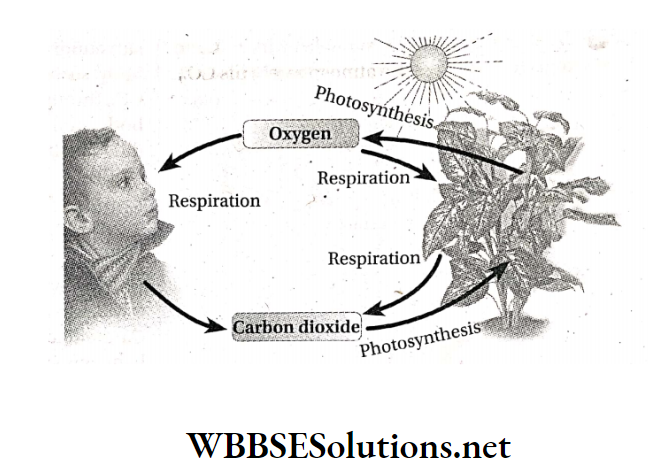Chapter 3 Physiological Processes Of Life Photosynthesis Long Answer Type Questions
WBBSE Life Science And Environment Class 9 Solutions
Question 1. Mention the source and role of the basic raw materials of photosynthesis.
Answer:
Source and role of basic raw materials of photosynthesis:
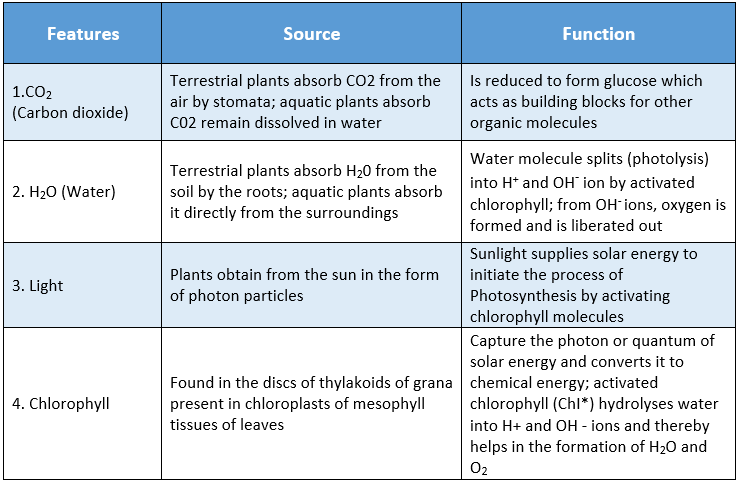
WBBSE Class 9 Photosynthesis Long Answer Questions
Question 2. Write the role of chlorophyll in photosynthesis. How is photosynthesis related to the flow of energy in the environment?
Answer:
Role of chlorophyll in photosynthesis:
Chlorophyll gets excited by the absorption of photon particles of sunlight and dissociates the water absorbed by the root hairs into H+ and OH– ions. Chlorophyll also converts solar energy into chemical energy which is stored within ATP in the form of potential energy.
Read and Learn More Class 9 Life Science Long Answer Questions
Relation of photosynthesis with energy flow in the environment:
- Green plants trap solar energy and store it within ATP in the form of chemical energy during the initial phase of photosynthesis.
- Later, this energy is converted to potential energy and remains stored within glucose, which is the end product of photosynthesis.
- On the other hand, a large part of the potential energy, stored in glucose, is used up for performing various metabolic activities and is released as heat energy.
- The remaining potential energy enters the body of the primary consumers (herbivores), and then secondary consumers carnivores. In this way, the energy reaches the ultimate consumers.
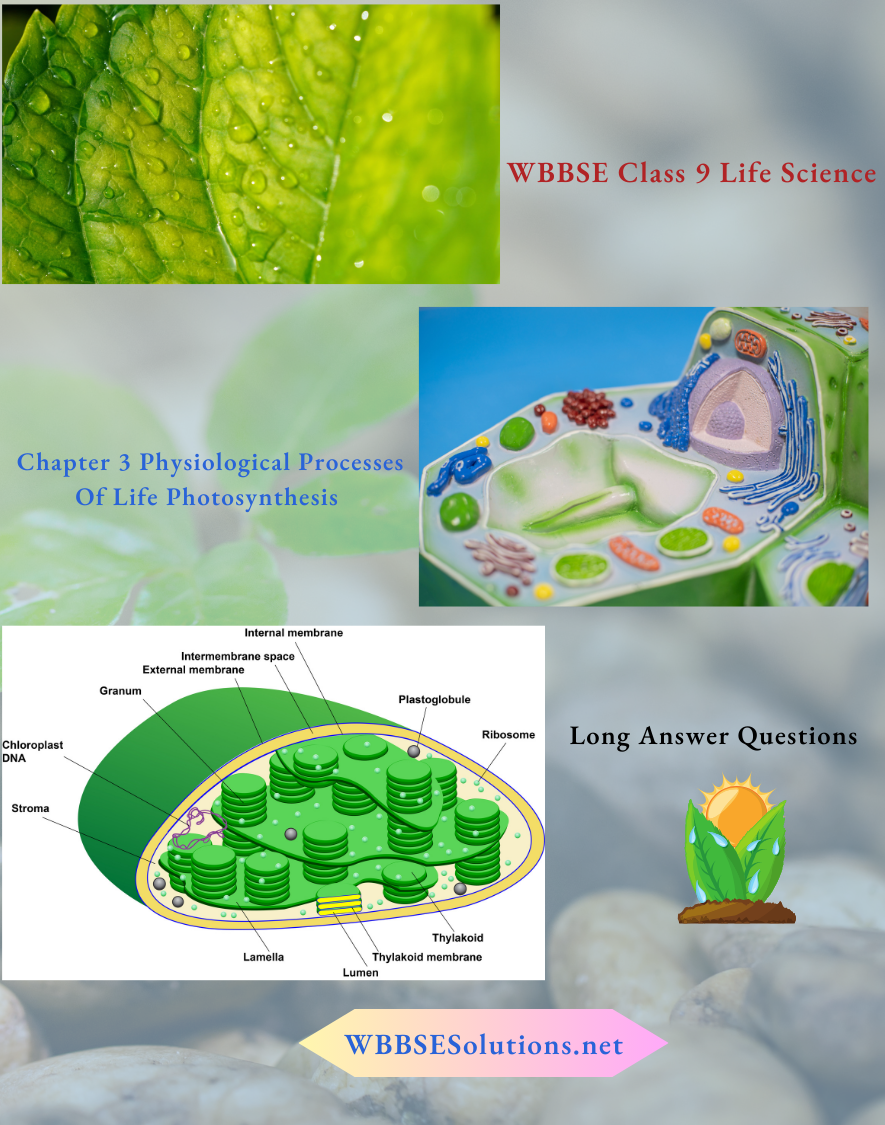
Key Long Answer Questions on Photosynthesis
- Decomposers, like various bacteria, fungi, etc. act on the dead bodies of these consumers, and the energy, thus, is recycled back into the environment through their decomposing activities.
- Thus, solar energy returns to the environment after passing through producers and various consumers, and decomposers. In this way, photosynthesis is related to energy flow in the environment.
WBBSE Life Science And Environment Class 9 Solutions
Question 3 Mention the name, location, and functions of the main pigments for photosynthesis.
Answer:
Name, location, and function of main photosynthetic pigments:
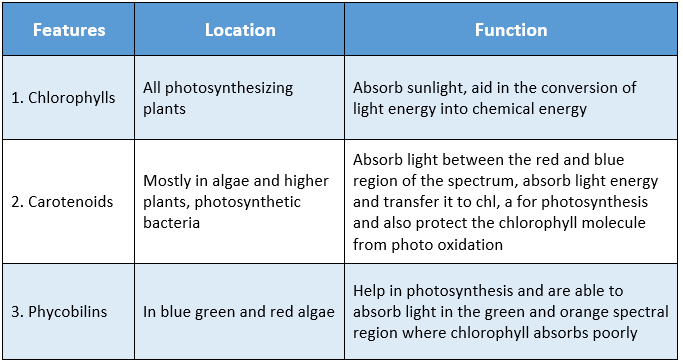
Important Long Answer Questions for Chapter 3 Life Science
Question 4. Write the differences between absorption and action spectra. Why leaf is the ideal place for photosynthesis?
Answer:
Difference between the absorption spectrum and the action spectrum
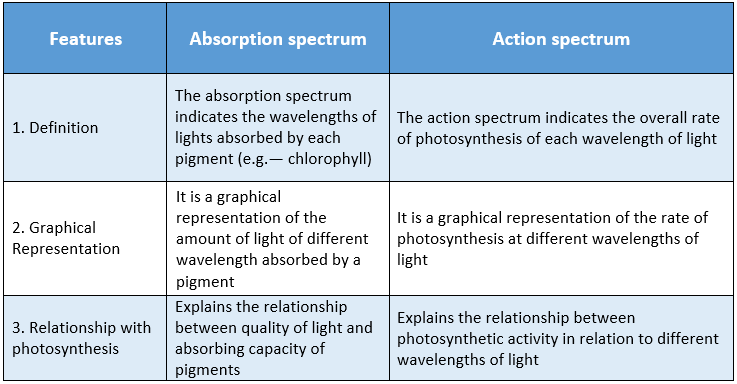
Leaf-the ideal place for photosynthesis:
- The broad shape of the leaf with a large surface area is adapted to absorb a large amount of sunlight.
- The large surface area of a leaf can accommodate a large number of stomata, thus more efficiently facilitating the exchange of gases per unit of time.
- Abundant intercellular spaces in mesophyll tissue help the rapid exchange of gases like O2 and CO2.
- Leaves have a vast network of conducting tissue to carry water to the cells and carry carbohydrate products away.
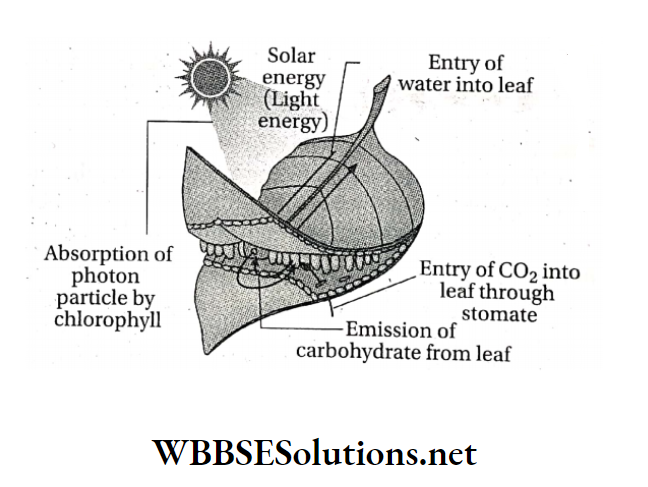
WBBSE Life Science And Environment Class 9 Solutions
Question 5 Briefly explain the chemical reaction of photosynthesis. Differentiate between primary photosynthetic pigments and accessory photosynthetic pigments.
Answer:
The chemical reaction of photosynthesis:
The equation of the chemical reaction of photosynthesis can be summarised as follows:
\(\underset{\text { carbon dioxide }}{6 \mathrm{CO}_2}+\underset{\text { Water }}{12 \mathrm{H}_2 \mathrm{O}} \underset{\text { Sunlight }}{\stackrel{\text { Chlorophyll }}{\longrightarrow}} \underset{6}{\mathrm{C}_6 \mathrm{H}_{12} \mathrm{O}_6}+\underset{\text { Oxygen }}{6 \mathrm{O}_2 \uparrow}+6 \mathrm{H}_2 \mathrm{O}\)
This equation can be explained as:
1. 6 carbon dioxide molecules and 12 water molecules react to produce one glucose molecule 6 molecules of oxygen and 6 molecules of water.
2. The reaction requires energy in the form of light (mainly sunlight) and occurs in the presence of the biocatalyst, a green pigment called chlorophyll.
3. Carbon dioxide and water combine through a number of chains. reactions to synthesize glucose.
4. Oxygen is evolved as a byproduct in this process.
Differences between primary photosynthetic pigments and accessory photosynthetic pigments:
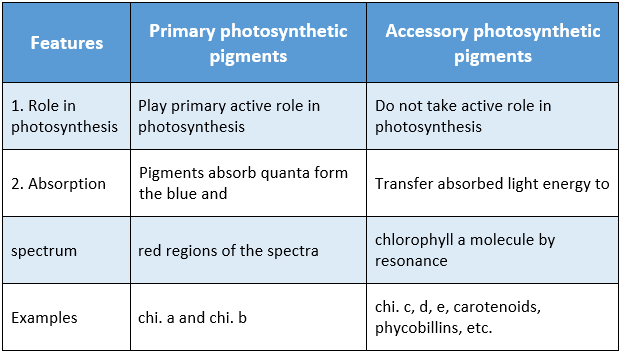
Practice Long Answer Questions on Photosynthesis
6 Briefly describe the reactions of the light-dependent phase of photosynthesis.
Answer:
Reactions of the light-dependent phase of photosynthesis:
The reactions of the light-dependent phase of photosynthesis occur in the grana of chloroplastids. ATP, NADPH2, H2O, and O2, are the end products of this light-dependent phase of photosynthesis.
Five different reactions occur in this phase, which are mentioned below:
1. Activation of chlorophyll:
Solar energy reaches the earth in the form of energy-packed particles, called photons. When these photon particles hit the chlorophyll molecules present in the chloroplast of mesophyll tissue, they get excited and release energized electrons. This event is known as the activation of chlorophyll.
![]()
2. Photolysis of water:
Activated chlorophyll dissociates water molecules into hydrogen ions or protons (H+) and hydroxyl ions (OH–). This light-dependent dissociation of the water molecules is called photolysis or ionization of water.

3. Reduction of NADP+:
NADP is a proton acceptor, present in the chloroplasts. Proton (H+) produced during the photolysis of water, reacts with NADP+ and reduces it to produce NADPH + H+. In this reaction, necessary electrons for the subsequent reactions are emitted from the excited chlorophylls.
![]()
4. Production of oxygen:
Hydroxyl ions (OH¯), produced during the dissociation or photolysis of water, release electrons and are transformed into hydroxyl radicals [OH]. These radicals combine to form water (H2O) and oxygen (O2) molecules.
![]()
5 Photosynthetic phosphorylation: The energized electrons, released from the photon-hit chlorophylls, help to combine adenosine diphosphate (ADP) and inorganic phosphate (IP) to produce an energy-rich compound, called adenosine triphosphate (ATP). This reaction is known as photosynthetic phosphorylation or photophosphorylation.
∴ \(\mathrm{ADP}+\mathrm{Pi} \longrightarrow \text { ATP }\)
Concepts Related to Photosynthesis for Long Answers
Question 7. Briefly describe the steps of the light-independent phase of photosynthesis along with a diagram.
Answer:
The steps of the light-independent phase of photosynthesis:
The reactions of the light-independent phase occur in the stroma of chloroplastids. The end product of this phase is glucose (carbohydrate) and RuBP is synthesized. Four different reactions occur in this phase of photosynthesis. These are described in the following matter.
1. Carbon assimilation:
Photosynthetic plants absorb CO2, from the atmosphere. This CO2 reacts with RuBP in the stroma of chloroplast to produce phosphoglyceric acid (PGA). The enzyme RuBis CO2 catalyzes this reaction. In this reaction, the carbon atom (C) of CO2 is assimilated within the cellular organic compounds. This reaction is known as carbon assimilation.

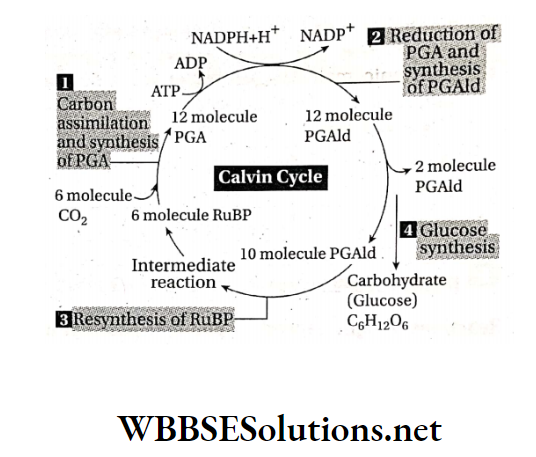
2 Reduction of PGA:
In this step, two products of the light-dependent phase, namely NADPH + H+ and ATP come into action. NADPH + H+ reacts with phosphoglyceric acid and reduces it to produce phosphoglyceraldehyde (PGAld). ATP supplies the necessary chemical energy for this reaction.
∴ \(12 \mathrm{PGA}+12\left(\mathrm{NADP}+\mathrm{H}^{+}\right)+12 \mathrm{ATP} \longrightarrow 12 \mathrm{PGAId}+12 \mathrm{NADP}++12 \mathrm{ADP}+12 \mathrm{Pi}\)
3 Resynthesis of RuBP:
Out of the total PGAld produced, 5/6th part undergoes a cycle of reactions and resynthesizes RuBP. This reaction of resynthesis of RuBP occurs in a cyclic manner. This reaction cycle is named the Calvin cycle.
As scientist Melvin Calvin first traced this cycle, this cycle is named the Calvin cycle. In this cycle, several intermediate compounds are produced in subsequent steps.
4 Glucose synthesis:
Out of the total PGAld produced, 1/6th part takes part in the synthesis of glucose. Within the stroma of chloroplasts, PGAld molecules undergo a series of reactions to synthesize glucose.
2\(\text { PGAId } \longrightarrow \mathrm{C}_6 \mathrm{H}_{12} \mathrm{O}_6 \text { (Glucose) }\)
WBBSE Life Science And Environment Class 9 Solutions
Question 8 Write the significance of the light-dependent phase of photosynthesis. What is the significance of the light-independent phase of photosynthesis?
Answer:
Significance of the light-dependent phase of photosynthesis:
1. During photophosphorylation of the light-dependent phase, solar energy is converted into chemical energy and is stored as ATP.
2. ATP, produced during photophosphorylation, and NADPH+H+, produced during the reduction of NADP+, in the light-dependent phase, help in the reduction of PGA to PGAld, later in the light-independent phase.
3. During the Hill reaction, water gets dissociated to liberate oxygen. This oxygen helps in the respiration of all living organisms as well as in combustion.
Significance of light-independent phase of photosynthesis:
1. Solar energy gets stored in glucose as potential energy. This energy helps the living world, directly or indirectly, to perform all metabolic activities.
2. The CO2 released into the environment by all organisms during respiration, is taken up by plants during the light-independent phase. As a result, the balance of CO2 and O2 is maintained in the environment.
3. During this phase, the assimilation of carbon takes place, and carbohydrates, in the form of glucose, is produced as an end product. This glucose, either directly or indirectly, is the source of food for all heterotrophic living organisms.
Sample Long Answer Questions from WBBSE Class 9 Life Science
Question 9 What is the significance of photosynthesis?
Answer:
Significance of photosynthesis:
1. Trapping and transformation of solar energy:
Solar energy from the sun is trapped by chlorophyll and transformed into chemical potential energy in the glucose molecule. This energy is then passed on from the producers (plants) to the consumers through the food chain and is liberated during respiration.
2 Source of food:
Through the process of photosynthesis, inorganic materials like water and CO2 combine to produce organic molecule glucose, which is the basic component of all food matters on earth. Not only plants, but other animals also obtain this food, either directly or indirectly, to survive.
3 Maintainance of O2 and CO2 balance in the environment:
During respiration, all living organisms release CO2 and absorb O2. On the other hand, green plants release O, and
4 Source of fuel:
Due to natural disasters, like earthquakes, plants get trapped under the soil and in due course of time get converted into coal and mineral oils. The energy obtained from these coal and mineral oils originally is solar energy which was entrapped by the plants in the past. This is how photosynthesis is the only source of different types of fuel.
5 Sources of human welfare:
We get different types of important materials from plants, like food, wood, paper, cloth, rubber, gum, paint, etc. Apart from these, we get different alkaloids like morphine, quinine, reserpine, etc., and various medicines from plants. Therefore, plants, more specifically photosynthesis, is very important physiological process for human welfare.
